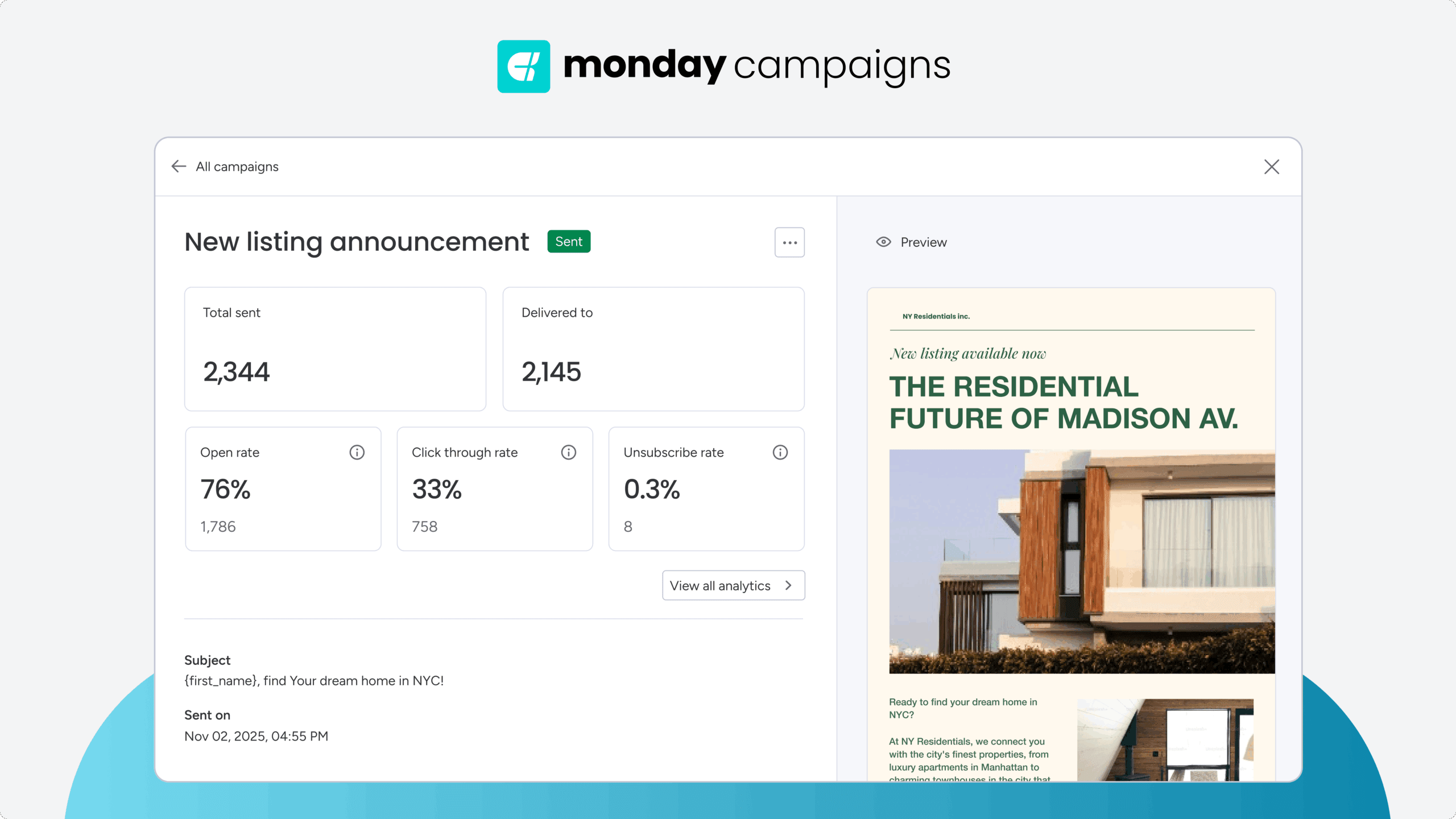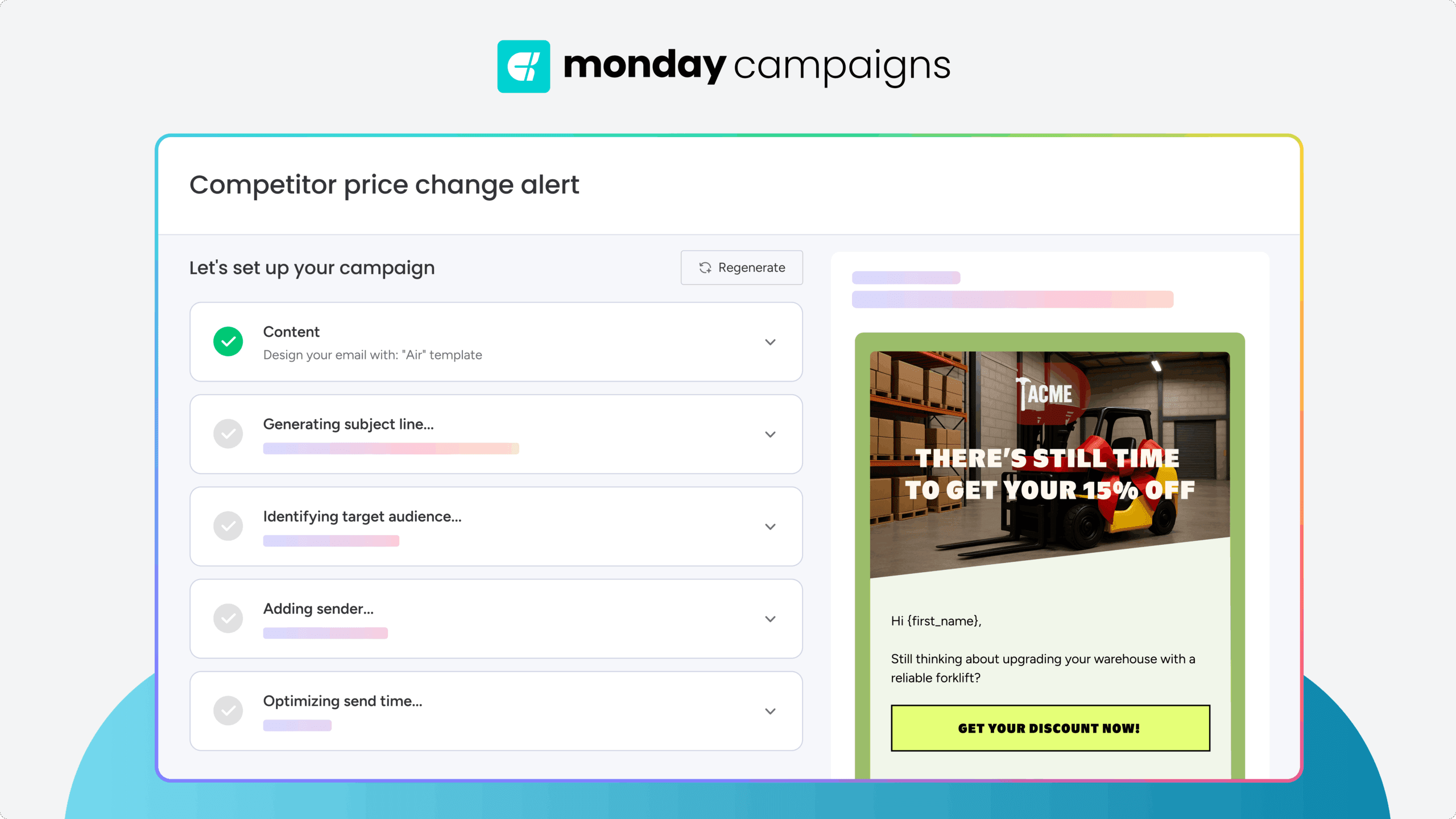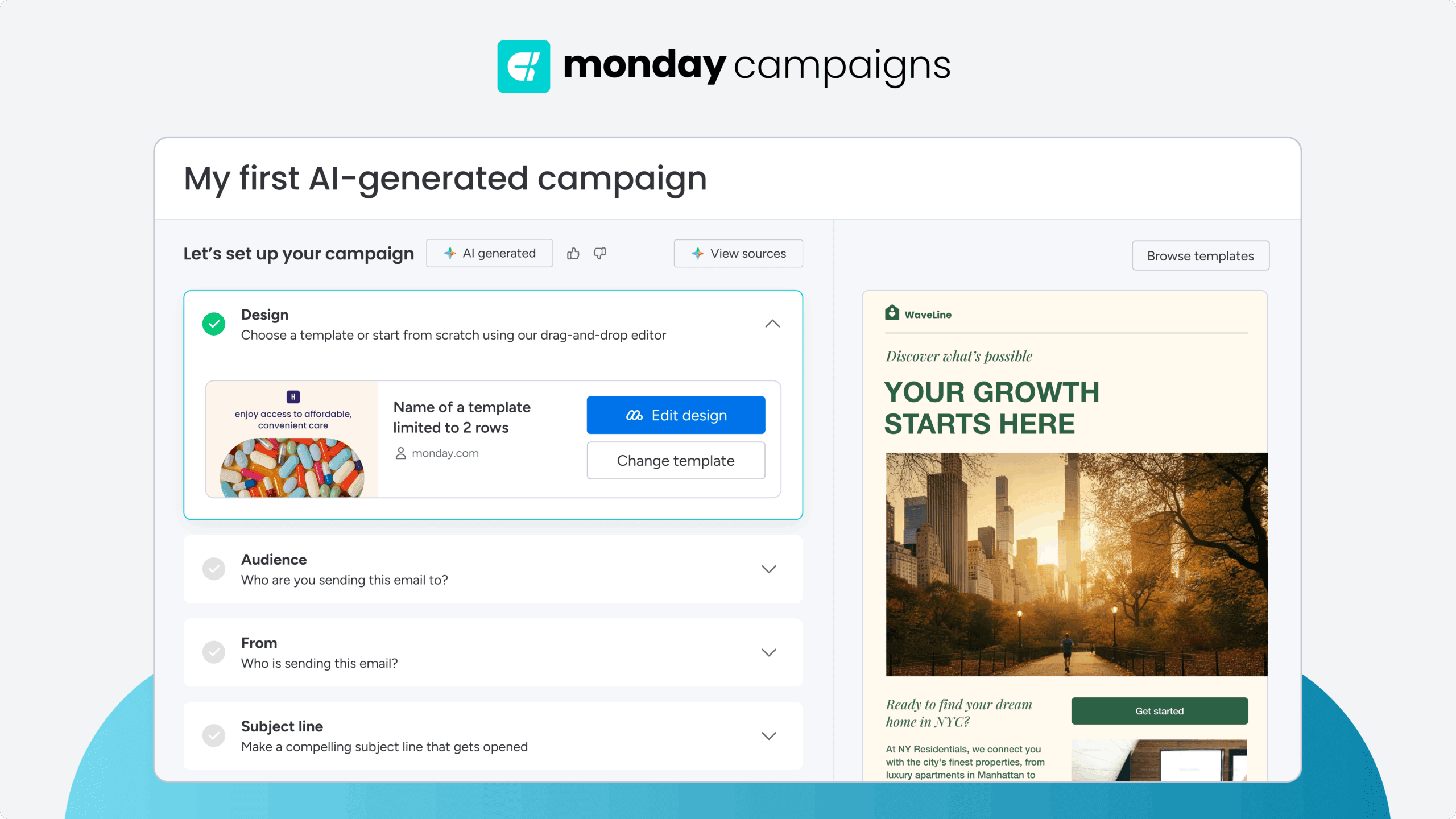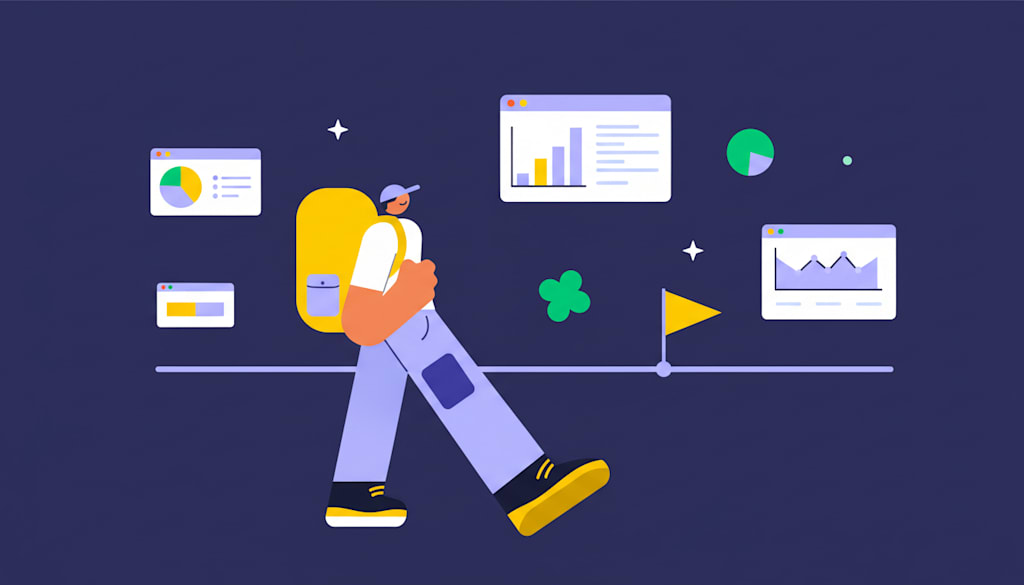Imagine sending an email that arrives at the exact moment a subscriber opens their inbox. It’s not luck — it’s send time optimization, an AI-powered strategy that analyzes individual subscriber behavior to deliver your message when they’re most likely to engage. This approach connects marketing efforts to real customer habits, turning broadcasts into perfectly timed conversations that drive higher open rates and stronger results.
This guide walks through how send time optimization works, from the AI models that predict engagement to the strategic benefits that improve marketing ROI. We’ll explore how to implement it successfully and coordinate it with your CRM for a full view of the customer journey, helping you move beyond batch sending and start delivering emails that people actually want to open.
Try monday campaignsKey takeaways
- Send time optimization uses AI to deliver emails when each subscriber is most likely to engage, dramatically boosting open rates and clicks compared to traditional batch sending.
- This personalized timing approach reduces unsubscribes and email fatigue by respecting individual preferences, keeping subscribers engaged longer and improving your sender reputation.
- Successful implementation requires 3–6 months of engagement data and consistent email sending, with most marketers seeing initial improvements within 2–4 weeks.
- The strategy drives measurable revenue growth by improving marketing-sales alignment and delivering higher engagement rates that translate directly into more conversions.
- AI-powered timing recommendations start working from day one with monday campaigns, which connects directly with your CRM to optimize emails throughout the entire customer journey.
What is send time optimization?
Send time optimization (STO) is an AI-powered email marketing approach that analyzes each recipient’s behavior to determine the ideal moment to deliver your message. Instead of relying on generic rules — like “Tuesdays at 10 a.m. work best” — STO uses real engagement patterns to personalize send times at the individual level. That means your emails land when each subscriber is most likely to open and act on them, not when you hope they will.
Think of it like having a personal assistant who knows exactly when every contact tends to check their inbox. AI models learn from patterns such as when someone typically opens emails, how frequently they engage, and what devices they use, then use that data to predict the optimal send window for future campaigns. It’s a smarter, automated way to increase open rates, click-throughs, and overall engagement without manually testing dozens of send-time variations.
The evolution from batch sending to personalized timing
Email marketing began with a simple approach. Write an email, pick a time, and send it to everyone at once. This batch-and-blast method ignored a basic truth: People check email at different times based on habits, routines, and daily rhythms.
Time zone sending was the next improvement. It delivered messages at the same local time across regions, which was a major upgrade for global teams. But it still assumed that everyone in the same time zone behaves the same way — even though some subscribers check email before sunrise while others don’t open anything until late evening.
Modern send time optimization (STO) takes personalization much further. Instead of assigning a single “best” time, STO uses AI to analyze each subscriber’s real engagement patterns and deliver emails when they are most likely to open and interact.
Here’s how the approaches compare:
| Approach | How it works | Strengths | Limitations |
|---|---|---|---|
| Batch sending | Everyone receives the email at the same moment (e.g., 9 a.m. EST). | Simple to execute. | Ignores location, behavior, and engagement patterns. |
| Time zone sending | Sends at the same local time across geographic regions (e.g., 9 a.m. per time zone). | Better for global lists; more relevant than batch. | Assumes people in the same time zone behave identically. |
| Send time optimization (STO) | Uses AI to deliver each email at the time each person typically engages. | Maximizes opens and clicks by personalizing send times. | Requires behavior data to perform well. |
STO captures the nuance that older methods miss. It knows one subscriber might reliably check email at 7:15 a.m. during a morning commute, while another tends to open messages during a 12:30 p.m. lunch break. By predicting and adapting to these real patterns, STO sends each email at the moment it’s most likely to drive engagement.
Why “best send times” don’t work anymore
If you’re looking for guidance that says “For X industry, it’s best to send on this day at this time,” we have news for you.Traditional “best time to send email” studies average millions of send times across industries, but they don’t account for your actual audience. STO replaces one generic best time with individualized predictions.
How send time optimization transforms email performance
When emails arrive at the right moment, everything changes. Messages get seen instead of buried. They feel relevant instead of disruptive. And engagement naturally rises because the timing aligns with how people already use their inbox.
This isn’t just about convenience — it’s about respecting real behavior and using AI to automate timing in a way humans never could. Some people check email before sunrise, others during lunch, and many only catch up after work. Send time optimization adapts to those patterns at scale.
Higher engagement through behavioral targeting
Behavioral targeting is about understanding not just who your subscribers are, but how they interact with email. Send time optimization uses this insight to increase opens and clicks by delivering each message during a subscriber’s natural engagement window.
When emails land at the moment someone is already primed to check their inbox, engagement rises. It’s not magic — it’s timing.
Here’s how it plays out across different subscriber types:
- Morning people open emails with their first coffee.
- Lunch-hour browsers:check messages during midday breaks.
- Evening readers skim newsletters after work or once kids are asleep.
- Weekend warriors clear out their inbox on Saturdays or Sundays.
Send time optimization meets each group where they already are.
Reduced unsubscribe rates and improved deliverability
Consumers have a low tolerance for emails that feel intrusive. GetApp’s Advertising Preferences Survey found that 56% of U.S. consumers will unsubscribe after just 4 marketing emails in 30 days — and 44% will opt out even sooner.
Mistimed emails often feel like high-frequency emails, even if your actual email cadence is reasonable. STO helps counter that perception. When messages consistently arrive at times that make sense for each subscriber, they feel less like interruptions and more like welcome updates, which reduces the likelihood of opting out.
These improved engagement signals also feed directly into deliverability. Email providers monitor opens, clicks, and spam flags to determine sender reputation. When your audience interacts more with your messages, inbox placement improves — making STO a quiet but powerful driver of long-term email performance.
Try monday campaignsHow AI-powered send time optimization works

AI-powered send time optimization starts by collecting data about when each subscriber interacts with your emails. The system tracks opens, clicks, and other engagement signals across multiple campaigns.
Machine learning algorithms then analyze this data to find patterns. They identify not just when someone opened an email once, but when they consistently engage across days, weeks, and months, allowing teams to combine these insights with time-tracking software for holistic performance monitoring.
The AI continuously refines these predictions as new data comes in. If someone’s schedule changes — maybe they switched jobs or time zones — the system adapts automatically.
Machine learning models that predict engagement
Machine learning models excel at finding patterns humans might miss. They process thousands of data points to understand each subscriber’s unique rhythm.
The models consider multiple factors simultaneously. Time of day matters, but so does day of week, device type, and even email content type. A subscriber might read newsletters on Sunday mornings but prefer promotional emails on weekday evenings.
These predictions improve over time through continuous learning. Every email sent provides new data that helps refine future timing decisions. monday campaigns leverages this continuous improvement to ensure your campaigns always hit the optimal window.
Behavioral data that powers optimization time
The quality of send time optimization depends on the behavioral data feeding it. Understanding what data matters helps you appreciate how these systems achieve such precise timing.
Essential data points that drive accurate predictions include:
- Open times: When subscribers actually read emails, not just when delivered
- Click patterns: Which times generate not just opens but meaningful engagement
- Device usage: Mobile vs. desktop behavior often indicates different timing preferences
- Frequency preferences: How often someone engages helps predict when they’re most receptive
Continuous learning and adaptation
Send time optimization never stops learning. As subscribers’ lives change, so do their email habits. The AI tracks these shifts and adjusts accordingly.
This adaptation happens automatically. You don’t need to manually update preferences or segment lists based on new patterns. The system handles it all in the background.
The continuous learning also accounts for seasonal changes, holidays, and other factors that affect email behavior. Your optimization stays current without constant oversight.
5 strategic benefits that drive email marketing ROI
Send time optimization delivers concrete benefits that directly impact your bottom line. These advantages compound over time, creating lasting improvements in your email program performance.
Understanding these benefits helps justify the investment and set appropriate expectations for results. Each benefit builds on the others, creating a virtuous cycle of improved performance.
1. Higher open and click-through rates
The most immediate benefit appears in your core email metrics. When messages arrive at optimal times, more people open them. Simple as that.
But the impact goes beyond opens. Subscribers who open emails at convenient times are more likely to click through and take action. They’re in the right mindset to engage with your content. This improvement happens across all campaign types — newsletters, promotions, and transactional emails all benefit from optimal timing.
2. Reduced email fatigue and unsubscribes
Email fatigue happens when subscribers feel overwhelmed by poorly timed messages. Send time optimization prevents this by ensuring emails arrive when people actually want to read them.
The result? Fewer unsubscribes and spam complaints. Subscribers stay on your list longer because you’re respecting their time and preferences. This retention improvement has compound effects. Keeping subscribers engaged over time increases their lifetime value and reduces the cost of constantly acquiring new contacts.
3. Stronger marketing-sales alignment
When marketing emails generate engagement at optimal times, sales teams receive warmer leads. Prospects who just opened and clicked an email are more receptive to follow-up.
This timing alignment accelerates the sales process and boosts sales productivity by focusing efforts on leads at their peak interest. Instead of cold outreach hours or days after email engagement, sales can connect while interest remains high.
4. Enhanced customer experience and relevance
Respecting subscriber preferences through optimal timing improves the overall customer experience. People appreciate brands that understand their schedules and communicate accordingly.
This enhanced experience builds brand loyalty. Subscribers develop positive associations with your emails because they consistently arrive at convenient times. The relevance extends beyond timing to perception. Well-timed emails feel more personalized and thoughtful, even if the content itself isn’t individually customized.
5. Measurable revenue impact
All these benefits ultimately drive revenue growth. Higher engagement leads to more conversions. Reduced unsubscribes mean larger, more responsive lists. Improved sales alignment accelerates deals.
The revenue impact is measurable and attributable. You can track how optimized send times affect not just opens and clicks, but actual purchases and customer lifetime value. This clear ROI makes send time optimization one of the most impactful email marketing investments available, further boosted by sales optimization strategies that convert engagement into revenue.
Try monday campaignsHow to implement email send time optimization successfully
Successful implementation starts with understanding what you need and setting realistic expectations. Send time optimization requires data, patience, and the right platform to deliver results. Most marketers see initial improvements within weeks, but optimal performance develops over months as the system learns subscriber patterns. Planning for this timeline ensures smooth adoption.
Essential data requirements
Send time optimization needs historical engagement data to make accurate predictions. Without sufficient data, the AI can’t identify reliable patterns.
The minimum requirements for effective optimization include:
- 3–6 months of engagement history: Enough data to identify consistent patterns
- Active subscriber base: Regular email activity provides fresh data for analysis
- Clean tracking: Accurate open and click data without technical issues
- Consistent sending: Regular email frequency helps establish behavioral patterns
Integration with your CRM platform
CRM integration supercharges send time optimization by adding business context to behavioral data. The system can consider not just when someone opens emails, but where they are in your sales funnel.
This integration enables more sophisticated timing strategies. A new lead might receive emails during business hours, while existing customers get messages timed to their personal preferences.
Testing and optimization strategies
Testing validates that send time optimization actually improves your results. Start with A/B tests and use specialized tools when comparing optimized timing against your current approach.
Measure not just open rates but downstream metrics like clicks, conversions, and revenue. This comprehensive view shows the full impact of optimized timing.
Continue testing different segments and campaign types. What works for promotional emails might differ from newsletter timing. Regular testing ensures you maximize results across all email types.

Send time optimization best practices for maximum impact
Maximizing send time optimization requires understanding nuances in subscriber behavior and adapting strategies accordingly. These best practices help you avoid common pitfalls and achieve superior results.
Implementation isn’t one-size-fits-all. Different audiences, industries, and campaign types benefit from tailored approaches to timing optimization.
Segment-specific timing strategies
Different audience segments exhibit unique engagement patterns. B2B subscribers often check email during business hours, while B2C audiences might prefer evenings or weekends.
Consider these segment-specific patterns when implementing optimization:
- Professional audiences: Typically engage during work hours, especially mid-morning and early afternoon
- Consumer segments: Show more varied patterns, often preferring personal time
- Geographic differences: Cultural norms affect when people check email
- Industry variations: Healthcare, retail, and finance professionals have different email rhythms
Multi-channel campaign coordination
Email doesn’t exist in isolation. Coordinating send time optimization with other channels, such as a social media posting schedule, prevents message fatigue and improves overall campaign effectiveness.
When email, SMS, and push notifications all arrive simultaneously, subscribers feel bombarded. Spacing these touchpoints based on optimal timing for each channel improves the experience.
This coordination requires visibility across all marketing channels. An integrated platform like monday campaigns makes this orchestration more manageable by connecting email with other marketing workflows.
Performance monitoring and adjustment
Send time optimization isn’t set-and-forget. Regular monitoring ensures the system maintains effectiveness as subscriber behavior evolves.
Track key metrics over time to identify trends and opportunities. Look beyond basic engagement to understand how timing affects business outcomes.
Adjust strategies based on performance data. If certain segments show declining engagement, investigate whether their optimal times have shifted.
How monday campaigns revolutionizes send time optimization
Transform send time optimization from a complex technical challenge into an intuitive marketing capability with monday campaigns. The platform combines AI-powered timing with comprehensive campaign management, meaning you don’t need separate tools for email creation, sending, and optimization. Everything works together in one unified platform.
AI recommendations from day one

Unlike platforms that require months of data before providing timing recommendations, monday campaigns offers AI-powered suggestions immediately. The system uses aggregated behavioral data to provide initial guidance while learning your specific audience patterns.
This immediate value accelerates your email program improvement. You don’t wait months to see benefits — optimization begins with your first campaign.
As the platform gathers data about your specific subscribers, recommendations become increasingly personalized and accurate.
Native CRM integration for smarter timing
With monday campaigns’ built-in CRM integration, you get more intelligent timing decisions. The system considers not just email behavior but complete customer context.
This means timing recommendations account for sales stage, customer value, and interaction history. A high-value prospect might receive different timing optimization than a long-term customer.
The integration also enables better attribution and ROI tracking. You can see exactly how optimized timing affects not just engagement but actual revenue.
Real-time optimization across the customer journey
Send time optimization in monday campaigns adapts throughout the entire customer lifecycle. New leads receive timing based on initial engagement patterns. Long-term customers get timing refined by years of behavioral data.
This journey-based optimization ensures relevance at every stage. As relationships evolve, so does the communication timing strategy.
The platform handles this complexity automatically. You focus on creating great content while the AI ensures it arrives at the perfect moment.

Transform your email strategy with intelligent send times
Send time optimization represents a fundamental shift in email marketing strategy. Instead of guessing when to send, you know. Instead of hoping for engagement, you maximize it.
The technology respects subscriber preferences while driving business results. It’s a win-win that builds stronger customer relationships and improves marketing ROI. Ready to stop guessing and start optimizing? Let AI transform your email timing strategy.
Try monday campaignsFAQs
How long does send time optimization take to show results?
To answer how long send time optimization takes to show results, it typically shows initial improvements within 2–4 weeks as the AI learns subscriber patterns. Full optimization usually develops over 2–3 months of consistent email sending and data collection.
Can send time optimization work with small email lists under 1,000 subscribers?
Send time optimization can work with smaller lists but becomes more effective with at least 1,000 active subscribers. Smaller lists may see improvements, but predictions become more accurate as list size and engagement data increase.
What's the difference between B2B and B2C send time optimization?
B2B send time optimization typically focuses on business hours and weekday patterns, while B2C considers personal schedules including evenings and weekends. B2B often sees engagement during work hours, while B2C patterns vary more widely based on lifestyle.
How does send time optimization handle global audiences across time zones?
Send time optimization automatically adjusts for time zones by analyzing when each subscriber engages in their local time. The system delivers based on individual behavior patterns within their time zone, not geographic assumptions.
What happens if a subscriber's email habits change significantly?
Send time optimization continuously adapts to changing patterns through machine learning. If someone's schedule changes due to a new job or lifestyle shift, the system automatically adjusts timing predictions based on new engagement data.
Is investing in send time optimization worthwhile for seasonal businesses?
Send time optimization provides value for seasonal businesses by adapting to changing patterns throughout the year. The AI learns seasonal engagement trends and adjusts timing strategies accordingly, maximizing performance during peak periods.
 Get started
Get started 

